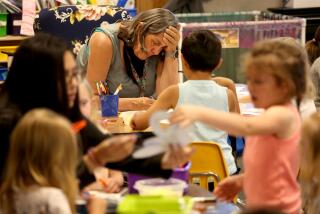Indian state grapples with teacher truancy
- Share via
KOINARA, INDIA — The students in the village elementary school here use burlap sacks for chairs. Barefoot, they sit or sprawl on the chilly cement floor of their bare-bones classroom, hunched over dog-eared workbooks, tapping their pencils in concentration. At lunch, they line up for a free hot meal, a powerful incentive for many of them to show up for school.
Whether their teacher does is another story.
As often as not, the teacher, Susari Aind, is nowhere to be found. Much of her time is claimed by duties off campus that have nothing to do with teaching.
If not for an extra instructor supplied by a local charity, learning for these 85 students would be scarce -- or even nonexistent, like electricity and running water.
“It’s only because of this extra teacher that we’re able to run this school,” Aind acknowledged after hurrying back to the two-classroom school upon being told that a foreign visitor had dropped in.
The situation in Koinara is far from unique. Every day across India, an estimated 25% of teachers in government primary schools fail to turn up for class, one of the most dismal rates of teacher absenteeism in the world. Only Uganda fared worse in a recent study by the World Bank.
Though many are dedicated professionals who care about their work, and some, like Aind, are asked to perform additional duties for government officials, some teachers simply take off to tend to family fields. Others shun the classroom in order to run more lucrative private tutoring businesses, at times hiring unqualified aides to cover for them at school.
They do this because they can. Like other civil servants, government-appointed teachers are guaranteed their jobs virtually for life, and powerful teachers unions discourage lawmakers from shaking up the status quo.
“No one can remove them. There is no question of disciplining them,” said T.K. Mathew, chief executive of Deepalaya, a nonprofit educational organization.
The chronic truancy is a heavy drag on India’s tottering education system, whose success or failure bears enormous implications for this land of 1.1 billion people and its rapidly expanding economy.
More than half of India’s population is younger than 25, a fact officials are fond of citing as a “demographic dividend” that will boost the nation’s workforce. But it could also prove a time bomb if many end up unlettered, unskilled and unhappy.
This country has long prided itself on producing some of the world’s top scientific and literary talent, trained at universities that are as exclusive and competitive as Princeton or Caltech. Only lately, however, has India begun paying commensurate attention to educating its youngest minds.
An aggressive push to raise enrollment and a spate of construction over the last five years have put millions more children in public schools, primarily in poor areas where families cannot afford to emulate the middle and upper classes, which have largely abandoned public education. The nationwide free-lunch program has also drawn in huge numbers of youngsters who might otherwise be sent out to herd animals or beg at stoplights.
But boosting student enrollment is only part of the equation. Improving attendance by teachers is quite another.
“If you look at the budget of education, 90% of the money goes to paying teachers,” Mathew said. “If the teachers are not delivering quality education, a major problem exists.”
That problem has been especially acute here in the eastern state of Jharkhand, where a 2004 World Bank study found that teacher absenteeism hit a national high of 42%.
With undulating hills and carpets of thick forest, the state is one of India’s most poverty-stricken, dotted with remote villages populated by subsistence farmers who plant and harvest rice the way their forebears did centuries ago.
The school construction drive has put a primary school in nearly every one of Jharkhand’s 37,000 villages. A recruitment campaign has doubled the teaching force to about 140,000, improving the ratio of one teacher for every 81 students to one per 46.
Yet only 6.3% of second-graders in Jharkhand can read at grade level, a drop from 7.6% in 2006 and below the already abysmal national average of 9%, according to a comprehensive national survey. More than half cannot recognize numbers higher than 10.
How much these statistics stem from spotty teacher attendance is subject to debate. Schools are also beset by such problems as a shortage of textbooks and basic facilities; the highest-tech item is often a piece of chalk. The “campus” is usually nothing more than two or three concrete rooms without any furniture or glass in the windows. Bathrooms can be a single outhouse.
Teachers here face other obstacles as well: the threat of violence from armed communist insurgents and dirt roads that become impassable during rains. But experts say the teachers’ job security has encouraged lackadaisical attitudes, despite monthly salaries of up to $300, an amount most residents here can only dream about.
The state hires teachers, who are supposed to be certified and go through a regular application process, but the awarding of such jobs can be influenced by corruption and patronage.
“There has to be some sort of pressure -- you don’t perform, you lose your job,” said Sukanya Subramanian, education project officer at the Jharkhand office of UNICEF. “Private school teachers make less but put in three times the work.”
Unannounced visits to five village schools in Jharkhand found only one where all the government-assigned teachers were present. In one instance, neither teachers nor students were anywhere to be found in the two classrooms.
Angela Guria, a mother of 7-year-old twins and a 5-year-old, all of them in first grade, said the head instructor seldom turned up.
“I’m not happy with the standard of education here,” said Guria, 35, “but I have no choice. I can’t afford to send them out of the village” to private schools, some of which charge $4 a month.
Teachers complain that they are often pulled out of the classroom by the government, which treats them as all-purpose state workers and saddles them with noneducational duties: taking census data, updating voter rolls, running vaccination programs, even counting cattle and sheep.
“We don’t see a teacher merely as a teacher. We see a teacher as a very important role model -- he should act as a catalyst for all the development in progress,” said Jyoti B. Tubid, secretary of the state’s Human Resource Development Department. “They should work as an agent of the government. They’re a symbol of the government.”
Here at the Koinara village school, teacher Aind said she was serving water to a visiting regional official when a foreign reporter arrived and found her gone. She blamed her frequent absences -- at least two days a week, she said -- on extra duties assigned her.
During her training, Aind said, “I thought I would be teaching kids. But when the government orders the teacher to run the polling booth in the school during elections, for example, you have to do it.”
In nearby Gopla village, teacher Kunthi Kumari acknowledged being absent from the classroom about a week every month, out trying to chase down her salary, fetching rice for the school lunch program, or attending one of 20 compulsory training sessions per year.
On this afternoon, her head teacher was gone, while another colleague appeared either hung over or ill. That left Kumari to cope with 100 energetic students from five grades.
When lunch was over, these sons and daughters of poor farmers would file back into their unheated, austere two or three classrooms. But would there be lessons for them? That seemed questionable.
“We’re able to give much less time to the kids,” Kumari said. “Education has suffered a lot, and it’s at its lowest point. We don’t feel good about that. We do our best to deal with the situation . . . but what can you do?”
--
More to Read
Sign up for Essential California
The most important California stories and recommendations in your inbox every morning.
You may occasionally receive promotional content from the Los Angeles Times.











